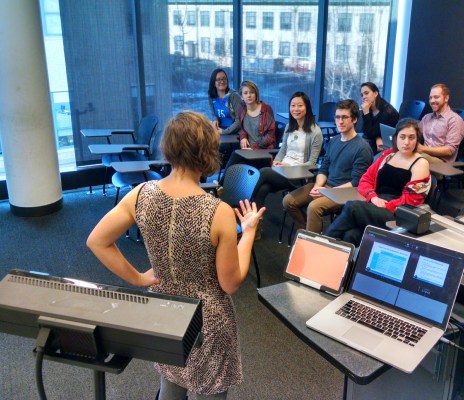Amy Ogan, an educational technologist at Carnegie Mellon University, calls herself a “CMU lifer” and for good reason. She nabbed both her undergraduate degree and Ph.D from the school. For the last couple of years, she has also worked at the university as an assistant professor, where she’s primarily focused on making classrooms, both online and offline, far more engaging.
Earlier this week, we talked with Ogan about how her team of researchers is right now trying to make good old-fashioned university settings more compelling through what they call “sensing.” Our chat has been edited for length.
TC: What inspired you to examine real-world classroom engagement?
AO: One of the motivations of this work is that with [online courses], we can collect data on what students are doing all the time, but there’s a lot that you can’t see, and a lot of those things demonstrate learning and give us better feedback. So we’re taking the idea back to the physical classroom first.
TC: You’re collecting talk data to start. What kinds of patterns are you looking for?
AO: The first thing is to just look at who is talking in the classroom, which is a major indicator of how students are doing — and how the teacher is doing, too. In many university classrooms, it turns out that not a lot of active learning is happening.
TC: What tech are you using to collect this data?
AO: We’re using sensors that aren’t expensive and can be set up in a variety of classrooms. You don’t need to build a million-dollar, state-of-the-art classroom. It’s microphones and cameras.
TC: What in the talk data tells you that students are engaged?
AO: We’re looking at the frequency of questions, but also how often the instructor is pausing. It’s been demonstrated that if you wait just three seconds after asking a question, you get orders of magnitude more participation from students in the class.
In fact, one approach we’re trying is when we detect that the teacher has been talking too long without interruption, we flash a big red screen on his or her laptop that sort of breaks that lecture mode and gets them to stop and solicit student participation.
TC: How do they react?
AO: They’ve been reacting favorably to it. The trick is not to interrupt the teaching in a way they can’t handle.
TC: And what are you doing with this analysis?
AO: We’ve figured out that the most productive approach is to incorporate some of this information into weekly training exercises for teachers and teaching assistants. One training exercise might prompt them to ask open questions that let students explore ideas, versus closed questions that check whether students have read materials. Then we look at week’s end to see whether they asked those open-ended questions.
TC: Who, or what, is poring over all this data?
AO: A research team here is working on it every day. But we’re working to verify that you can use machine learning to do this in a completely automated way, as if a human was analyzing the data.
TC: This is a research project, but if and when it’s time to commercialize it, what do you think the product might look like?
AO: It would be easy for any teacher to set up; they’d receive feedback in an automated fashion. They’d receive training exercises on a weekly basis that help them gauge how they’re doing. And they’d hopefully improve their own teaching and get better over time.
While we’re focusing on talk first, we’ll study facial reactions, too. A number of studies has shown how posture is related to student learning experiences, as well as how many people have their hands raised.
TC: You’re not alone in trying to measure student engagement. What’s your biggest differentiator?
AO: I’ve seen a number of desktop -based systems that feature teacher dashboards, so teachers can look at the work that students have done across classrooms and determine, say, maybe the most common error that students are making. The idea is a similar one [to ours] in that it allows you to collect data so you can make improvements. But [those existing systems] don’t show data about the teachers to better support learning. That’s really the piece that we’re trying to tackle — changing the way people approach teaching to turn lectures into more active participatory learning environments.
